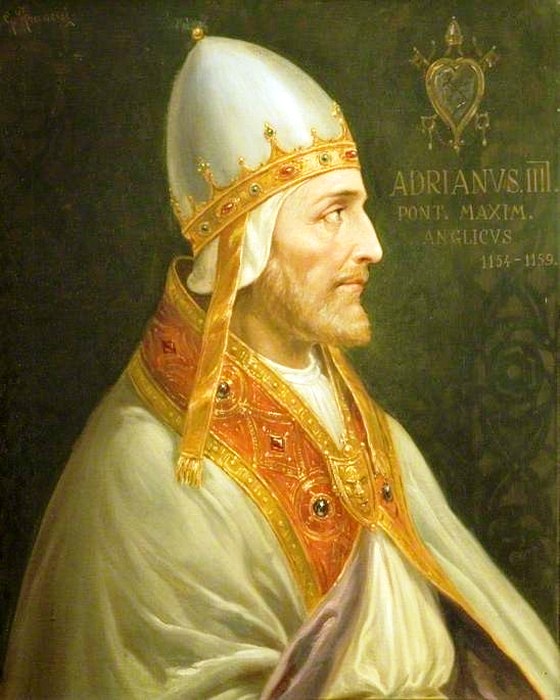Adrian IV (1100-1159)
Adrian IV (pope, 1154-1159), born Nicholas Breakspear in or near St. Albans, England, in 1100, remains the only Englishman to have ever ascended to the papacy. His early life was marked by academic and religious study, first at St. Albans Abbey and later in France, where he became a member of the Canons Regular of St. Rufus, an Augustinian order near Avignon. His abilities as a scholar and administrator saw him rise to the position of abbot, a role that proved to be a difficult tenure due to conflicts with his fellow canons, who resented his strict discipline and foreign origins.
Despite these challenges, Nicholas's reputation for organization, intellect and leadership brought him to the attention of Pope Eugene III, who made him a cardinal-bishop of Albano around 1149. Shortly thereafter, Eugene entrusted him with a diplomatic mission as papal legate to Scandinavia, where he was responsible for restructuring the church hierarchy in Norway and Sweden. His efforts led to the establishment of Norway's first independent archbishopric in Trondheim, which strengthened Rome's influence in the region. His success in this mission elevated his standing within the Church, and upon the death of Pope Anastasius IV in 1154, he was elected pope, taking the name Adrian IV.
Pontificate
Adrian IV inherited a papacy fraught with instability, particularly in Rome itself, where the rise of Arnold of Brescia, a radical monk advocating for a republic free from papal rule, had led to a crisis. Adrian's first act as pope was to reassert papal authority over Rome, leading to Arnold's arrest and execution with the assistance of Frederick Barbarossa, the Holy Roman Emperor. This, however, marked the beginning of an ongoing and often hostile relationship between Adrian and Frederick, as the emperor sought to revive imperial supremacy over the Church in the tradition of the Ottonian emperors.
At the Diet of Besançon in 1157, tensions between pope and emperor escalated when Adrian's legates presented a letter in which he used the term beneficium (benefit), which Frederick interpreted as meaning that he held the empire as a fief from the papacy. Outraged, Barbarossa rejected the claim, setting the stage for long-term friction between the papacy and empire.
Seeking alternative allies, Adrian attempted to forge ties with Byzantine Emperor Manuel I Komnenos, whose ambitions in Italy aligned with the pope's concerns over Norman power. However, this alliance failed to materialize, forcing Adrian to turn once again to the Normans of southern Italy, despite Rome's longstanding mistrust of their influence. Before any resolution could be reached, Adrian died unexpectedly on September 1, 1159, at Anagni, amid growing political turmoil in Rome.
Papal Schism and Aftermath
His death triggered a long and bitter schism that lasted 22 years, as rival factions within the Church disputed the legitimacy of his successor. Though Pope Alexander III was elected, the Holy Roman Empire supported the anti-pope Victor IV, a division that further destabilized the Papal States and heightened the struggle between the papacy and imperial power.
During Adrian IV's papacy, legend claims that he issued the Papal Bull Laudabiliter, granting King Henry II of England the right to invade and rule Ireland under the pretext of church reform. While no original copy survives, the document is cited in later sources and remains a controversial aspect of Adrian IV's legacy, particularly regarding England's long-standing involvement in Irish affairs.
Adrian IV's pontificate was defined by political turmoil, struggles for papal authority and the challenge of balancing power between the Holy Roman Empire, the Byzantine Empire and the Norman rulers of Italy. His legacy is one of resilience in the face of growing secular challenges, though his untimely death left many of his efforts unresolved.
